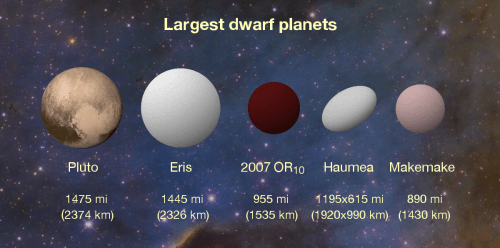A new study based on observations by the Kepler Space Telescope and the Herschel Space Telescope reveals that 2007 OR10, A celestial body unofficially considered a dwarf planet in a scattered disk at the edge of the solar system is even larger than previously thought. Its newly estimated diameter of 1,535 km makes it the third largest body in this distant region of the solar system, after Pluto and Eris. Now is the time, say his followers, to give him an official name.

2007 OR10 It is the largest body in the solar system still orbiting in the great nebula without an official name. It is at the edge of the solar system, in the area known as the "dispersed disk", even further away from Pluto and other objects in the Kuiper Belt, and is now 87 astronomical units from the Sun (an astronomical unit is the average distance between the Earth and the Sun - 150 million km).
New research, which is based on observations made by NASA's Kepler Space Telescope and old observations by the European Herschel Space Telescope, indicates that its estimated diameter is about 250 km larger than previously thought, with a diameter of about 1,535 km. For comparison, Pluto's diameter is 2,372 km.
Determining the diameter of such distant objects is not an easy task, because at their great distance they are seen as no more than a small spot even by the best telescopes and it is very difficult to estimate their physical parameters. For example, until the arrival of the New Horizons probe to Pluto last year, researchers were not sure whether Pluto was larger or smaller than the dwarf planet Eris. New Horizons finally discovered that Pluto is larger than it by only a few tens of kilometers.
In the great distance of 2007 OR10 and other objects in this region of the solar system, it is difficult to determine whether their apparent brightness is due to a smaller, brighter object that reflects more sunlight, or a larger, darker object that reflects less sunlight.
Until now researchers did not know the exact brightness of 2007 OR10. The Kepler space telescope was exactly suitable for this, which was launched into space in 2009 with the aim of locating extrasolar planets, but since a mechanical failure that happened to it in 2013, its mission has changed and it can now also study celestial bodies in our solar system. Kepler was adapted to measure slight dimming in the brightness of stars, making it possible to indirectly detect planets that pass between their star and the telescope and obscure a small portion of the star's light. This feature also made it excellent for measuring the brightness of the 2007 OR10. Combined with measurements of the dwarf planet's thermal radiation previously made by the European Space Agency's Herschel Space Telescope, the researchers were able to more precisely determine the diameter of 2007 OR10.
The new study suggests that the 2007 OR10 There is a lower brightness than previously thought, due to its greater size. One of the explanations that the researchers put forward for this is that there is methane ice on its surface. This hypothesis also fits its reddish color detected in the telescopic observations. Its greater size strengthens this hypothesis because its mass is large enough to prevent the methane from escaping into space due to too low a gravity.
According to the new 2007 OR study10 It is the third largest dwarf planet in the solar system, after Pluto and Eris. The one who doubts this statement is Mike Brown, one of the discoverers of the dwarf planet (who a few months ago participated in a study that predicted the existence of Ninth planet in the solar system, and also discovered many other celestial bodies in the Kuiper Belt region). Brown Tweet on the Twitter page His that "one should be skeptical that 2007 OR10 It is the third largest dwarf planet. Its size is measured in the least good way. He could easily be smaller than a maca-maca."
NASA and Brown do refer to the 2007 OR10 As a dwarf planet, but the International Astronomical Union officially recognizes only five - Ceres (which is in the asteroid belt), Pluto, Eris, Maka-Maka and Umiya. Additional entities such as 2007 OR10 And others that have already been given names such as Kwa-Var and Orcus are considered by many to be dwarf planets, but have not yet been officially recognized as such.
The new data reinforces the need to determine a name for this object, which should be given by its discoverers, with the approval of the International Astronomical Union. "The names of bodies the size of Pluto all tell a story about the characteristics of those bodies. Previously, we didn't know enough about 2007 OR10 To give him a name that will do him justice," she said In a message from NASA Meg Schwamb, one of his discoverers. "I think we have reached the point where we can give 2007 an OR10 His righteous name." Brown also joined and tweeted on his Twitter that they intend to give him a name soon.
